- Monilethrix
-
Monilethrix Classification and external resources ICD-10 Q84.1 (ILDS Q84.140) ICD-9 757.4 OMIM 158000 DiseasesDB 29592 eMedicine derm/763 Monilethrix (also referred to as "Beaded hair")[1] is a rare autosomal dominant hair disease that results in short, fragile, broken hair that appears beaded.[2][3] It comes from the Latin word for necklace (monile) and the Greek word for hair (thrix).[4]
Contents
Characteristics
The presentation may be of alopecia. Individuals vary in severity of symptoms. Nail deformities may also be present as well as hair follicle keratosis and follicular hyperkeratosis.
Cause and Genetics
Monilethrix is caused by mutations affecting the genes KRTHB1 (KRT81), KRTHB3 (KRT83), or KRTHB6 (KRT86) which code for type II hair cortex keratins.[5] The disorder is inherited in an autosomal dominant manner.[2] This means that the defective gene(s) responsible for a disorder is located on an autosome, and only one copy of the gene is sufficient to cause the disorder, when inherited from a parent who has the disorder.
Diagnosis
Monilethrix may be diagnosed with trichoscopy[6][7]
See also
References
- ^ James W, Berger T, Elston D (2005). Andrews' Diseases of the Skin: Clinical Dermatology (10th ed.). Saunders. ISBN 0721629210.
- ^ a b Celep, F.; Uzumcu, A.; Sonmez, F.; Uyguner, O.; Balci, Y.; Bahadir, S.; Karaguzel, A. (2009). "Pitfalls of mapping a large Turkish consanguineous family with vertical monilethrix inheritance". Genetic counseling (Geneva, Switzerland) 20 (1): 1–8. PMID 19400537.
- ^ Freedberg, et al. (2003). Fitzpatrick's Dermatology in General Medicine (6th ed.). McGraw-Hill. p. 639. ISBN 0071380760.
- ^ Genetic and Rare Diseases Information Center (2008-09-09). "Monilethrix". NIH Office of Rare Diseases Research. http://rarediseases.info.nih.gov/GARD/Condition/93/QnA/21422/Monilethrix.aspx#491. Retrieved 2011-01-15.
- ^ Schweizer J (2006). "More than one gene involved in monilethrix: intracellular but also extracellular players". J. Invest. Dermatol. 126 (6): 1216–9. doi:10.1038/sj.jid.5700266. PMID 16702971.
- ^ Rudnicka L, Olszewska M, Rakowska A, Kowalska-Oledzka E, Slowinska M. (2008). "Trichoscopy: a new method for diagnosing hair loss". J Drugs Dermatol 7 (7): 651–654. PMID 18664157.
- ^ Rakowska A, Slowinska M, Kowalska-Oledzka E,Rudnicka L. (2008). "Trichoscopy in genetic hair shaft abnormalities". J Dermatol Case Rep 2 (2): 14–20. doi:10.3315/jdcr.2008.1009. PMC 3157768. PMID 21886705. http://www.pubmedcentral.nih.gov/articlerender.fcgi?tool=pmcentrez&artid=3157768.
Congenital malformations and deformations of skin appendages (Q84, 757.4–757.5) Nail disease Hair disease hypotrichosis/abnormalities: keratin disease (Monilethrix) · IBIDS syndrome · Sabinas brittle hair syndrome · Pili annulati · Pili torti · Uncombable hair syndrome · Björnstad syndrome · Giant axonal neuropathy with curly hair
hypertrichosis: Zimmermann–Laband syndromeThis Condition of the skin appendages article is a stub. You can help Wikipedia by expanding it.

